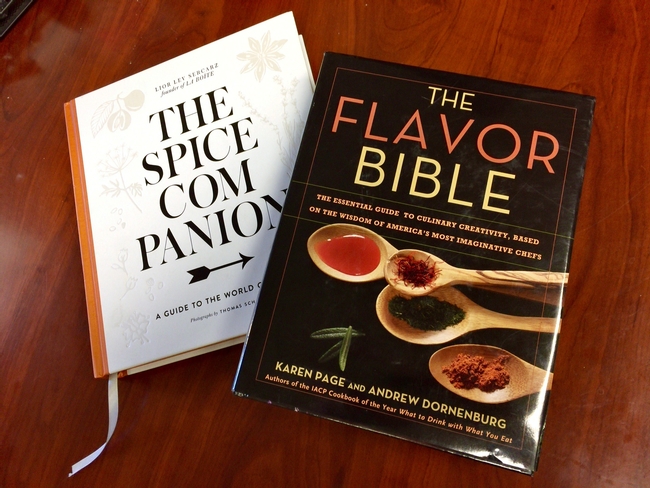Page, Karen and Dornenburg, Andrew. The Flavor Bible. Little, Brown and Co., 2008.
Sercarz, Lior Lev. The Spice Companion: A Guide to the World of Spices. Clarkson Potter, 2016.
One of the best things* about working in Cooperative Extension is that there always seems to be plenty of interesting food to try at the office. Between staff and volunteers, we get to try all sorts of flavors on a daily basis. I'm not sure we're at “arms race” status yet, but our office's nutrition educator, Amy Weurdig, just shared her newest tools to up her cooking game with us: two books about flavors and seasoning foods.
Along with working here at our office, Amy is a Master Gardener and a Master Food Preserver. She definitely gardens with food or drink in mind. Her latest plan is to grow saffron here in the Owens Valley. But what can you do with all that saffron, especially when you have a garden full of produce? After all, one zucchini plant, assuming you can keep squash bugs at bay, can feed a small army. Some creativity is needed to get it all used. And that's where seasonings and flavor pairings can come to play.
In her research Amy came across two interesting resources: The Flavor Bible by Karen Page and Andrew Dornenberg, and The Spice Companion by Lior Lev Sarcarz. These two books provide invaluable information about some key flavors we use in cooking, but they take a very different approach to the topic.
The Spice Companion is a beautiful book. (It covers many herbs, too, so don't worry if you're a spice-o-phobe.) Thomas Schauer's photographs and Nadine Bernard Westcott's illustrations, to me, are the highlight of this work. This is a book you will want on display, not jammed into the kitchen bookshelf next to the spiral-bound church cookbook you bought in 1983.
The book is organized as an encyclopedia of the world's spices. Each spice has a lovely illustration or photo, and possibly a food based on it as a key ingredient. Along with this artwork, there is text explaining its use, harvesting and botany. As an easy-to-use feature, each flavor has recommended food pairings, complementary spices, and recipe ideas. Reading through this book may inspire you to try a few new things since it contains some fairly obscure ingredients, but to me the best use would work like this: Let's say you planted a dozen pepperoncini plants in Spring and you're inundated with these peppers. What can you do with them besides make pickles or give them away? It turns out they're fairly versatile! I like its idea of using them to flavor an Italian-style bean dip. I see it as a fine book to browse while you're munching on a scone in the sunroom on Sunday morning.
The Flavor Bible takes a different approach to the topic of taste. Instead of an array of herbs and spices from A to Z, this book gets to business right away. While it is peppered with pictures of food, it is mostly text and is much more information dense. After 36 pages of how the book works (if you're impatient just read pages 35 and 36 get on with it) you are presented with over 350 pages of concepts, foods, flavors, and cuisines. Each entry will tell you when it is available, good ways to prepare, and recommended flavor pairings. The authors don't mince words here. This is a book you should look over to get familiar with, then keep nearby for reference. If you like to cook and eat more than read about and look at food then this no-nonsense book is for you. I see this as a book that will end up with stains and stuck together pages after a few years because you'll thumb through it with dirty fingers or a dripping spoon.
Some of the entries in The Food Bible are mundane, much like when the dictionary includes words like “smile” that you would never look up. For example there is an entry on sour cream that, naturally, suggests putting it on baked potatoes. However, most entries are more useful. The last entry “Zucchini Blossoms” should be of special interest to any gardeners who didn't realize all the fun things you can do there. I'm especially intrigued by its recommended pairing with lobster!
I probably gained 5 pounds just looking over these two books. (Reviewer's note: I was eating a giant burrito. Your experience may vary.) They are both full of ideas for the gardener with too much bounty, or one who is just bored and needs inspiration.
Either book will set you back about $40. If you are a passionate, but inexperienced or highly experimental cook—the kind who tends to wing it in the kitchen, you will probably appreciate The Flavor Bible. Those of you more set in your ways and just need some inspiration or would like to learn more about new ingredients will enjoy The Spice Companion. Both are good references, but they have very different approaches that may not appeal to everyone. I'm glad Amy bought both and let me review them both side by side.
Mmmm. Some butternut squash bisque with saffron sounds really good right now, Amy.
___________________
*Well it's good for my taste buds but not so much for my waistline.
